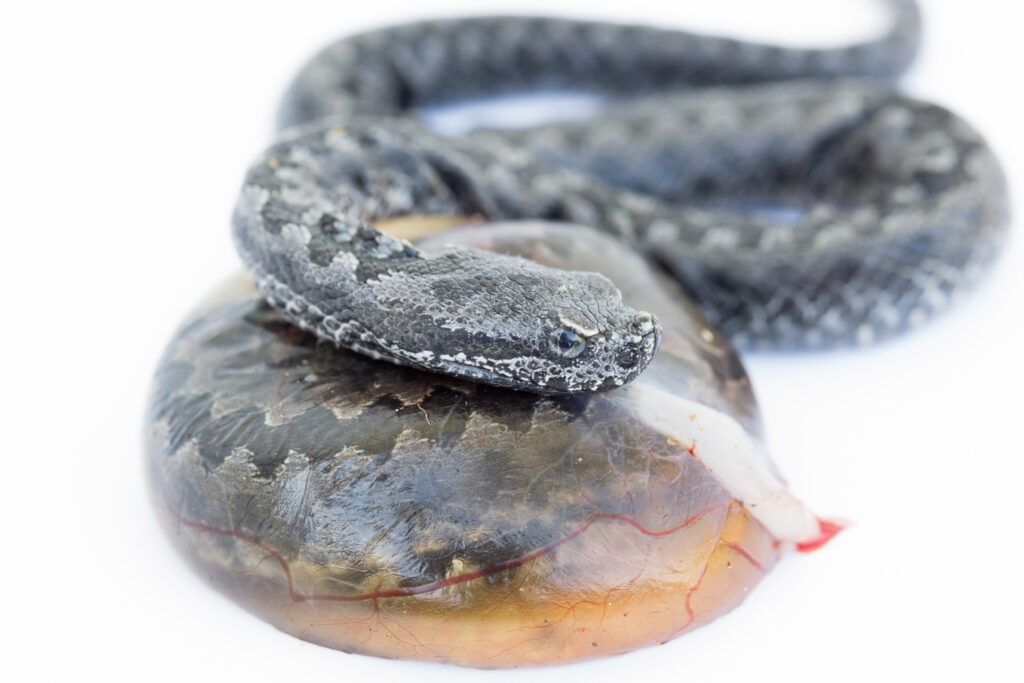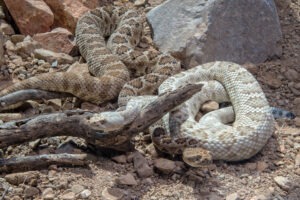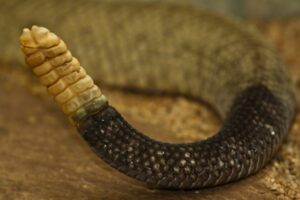
Rattlesnakes are reptiles and you would think that means they also lay eggs. But there are some reptiles out there that don’t lay eggs. So do rattlesnakes lay eggs?
Here’s how it works:
Rattlesnakes do not lay eggs, they are ovoviviparous and give live births. Instead of laying eggs that hatch outside the mother, the snake forms and incubates inside the body of the female rattlesnake in what could be called a sack or membrane, and they are birthed live in that.
The mother rattlesnake will carry her incubated eggs typically for 90 days, depending on the species! Then during the live birth, her babies come out fully developed. The whole process of her birth procedure is incredible and unique, so keep reading on!
What does it mean that Rattlesnakes are Ovoviviparous?
Ovoviviparous means that the animal doesn’t just lay eggs and it doesn’t just give live birth. It means that the animal will form the egg in its body with the baby inside and keep it there during the gestation period. After that, the baby rattlesnake will be birthed as it would during live birth
The shell of the egg will eventually reduce to just a membrane near the end of the gestation period.
(source)
In some cases, it stays in the womb a bit after the shell reduces to just a membrane and in others, it will begin the birthing process. If the baby remains in the womb for a time, it will develop a lot more like a teen than a baby.
If it is birthed immediately it will be a little less developed, and like a baby needs time to grow and learn to move around. During this process, the baby usually gets its nutrients from the yolk of the egg.
Creatures will adapt to this way of giving birth because of their environment.
This is a good way for these creatures to protect their eggs while they hunt for food; they don’t have to leave the eggs behind. It is also a great way to keep the eggs warm even if the climate begins to change because the bodies of the animal are keeping the eggs warm.
Some other ovoviviparous animals are rays, all types of rattlesnakes, basking sharks, some insects, some fish, and some other lizards.
What is the Mating Season for Rattlesnakes?
Spring to early summer is around the time most rattlesnakes begin mating. This lasts until early fall.
When it is mating season the female will usually leave a trail of her scent. The male then finds the scent and follows it to the female. If two males find the female they must fight for her attention. Only the winner will be allowed to mate with the female.

The female will normally be somewhere out in an open and safe area, basking in the sun. she will take in as much heat as possible to warm up her body.
This is done so that she can be prepared to mate and provide warmth for her future babies.
Her body warmth provides the perfect environment for the incubation of the eggs that she will carry inside of her for the next few months or so, depending on the rattlesnake species.
Rattlesnakes typically have their babies in the fall because they are cold-blooded reptiles. The mother rattlesnakes will rely heavily upon the heat from the summer season.
From late summer to early fall is when rattlesnakes usually begin having their babies.
However, rattlesnakes only give birth about every 2 years. So if you have a couple of pet rattlesnakes, you won’t have to worry about babies every year. (Although they are not sold in pet stores because they are poisonous.
You should be wary of having one of these reptiles as a pet unless you can provide them with adequate space and care and keep your distance from them). Rattlesnakes can conceive about 25 babies in the womb, but normally only 4-10 will survive, though this differs by rattlesnake species.
The Gestation Period for Rattlesnakes
The gestation period (the time in which the mother is pregnant) lasts about 3 months for a rattlesnake. However, for the timber rattlesnake, it can last up to 5 months.
The baby begins developing in the egg in the womb because rattlesnakes are ovoviviparous. Snakes have adapted to this way of pregnancy and birth because the mothers will need time to hunt during the day. It would be bad for the mothers to just leave the eggs exposed to the cold or predators.
So the mother will always carry the babies with her during the time she is pregnant.
The babies are not connected to the mother through an umbilical cord because the babies are in little eggs. To receive nutrients the babies will eat the yolk that is within the egg. The nutrients that the baby rattlesnakes feed on through the egg yolk are all provided by the mother rattlesnake.
During this time the shell of the egg will begin to reduce its thickness.
Instead of being a hard shell, like other reptilian or bird eggs, they will become a thinner, slimy layer of membrane around the baby. This will keep all the nutrients in until the baby has eaten all the yolk.
After the nutrients have been eaten and the membrane has fully developed, the babies are ready to be born.
At this time the babies are also developed enough to move on their own once they are born. There won’t need to be a time of incubation for them after they are born. But they will be born curled up as they would be in an egg.
How Rattlesnakes are Born
A mother rattlesnake will begin feeling contractions and shortness of breath around the time it is to start giving birth. It will take about 4 to 6 hours to give birth to all the babies. When the babies are born they will still be wrapped up in the membrane.
This means that they will come out middle first and curled up.
The babies will begin moving quickly to break free from the membrane. The baby rattlesnake will need to break the membrane so that it can take its first breath of fresh air. Soon the baby will be able to crawl away on its own and move around. The babies can range from 6-12 inches in length.
Normally once the baby rattlesnake breaks free from the membrane, it will wipe its eyes on its mother’s scales, so that it can more clearly see. Each rattlesnake will move out of the way so that the next baby can emerge out of the mother snake.
Once they are all born they will then explore a little around their new home.
After birthing 4-10 babies the mother may also release a pile of unfertile eggs as well. It is best to just get rid of these. You can eat snake eggs, but only those that actually have eggs that hatch with time. You should not eat the rattlesnake’s unfertile eggs.
After the baby rattlesnakes are born, a protective type of film will start appearing over their eyes. They can still see and will soon grow out of it as they start the process of their first shedding.
After they shed, the newborn smell will go away and they will stop attracting predators by that scent. This is another reason that their mother does not stay with them for long, because she will want them to protect themselves without her help.
Now if you have the stomach to watch, this video by CBC Docs shows the incredible process of a mother rattlesnake giving birth. You can watch below if you want to see how mature these baby rattlesnakes really are once they are born!
The Baby Rattlesnake’s Life With its Mother
After the neonate (baby rattlesnake) is born and able to move around, the mother only sticks around for about a week to 10 days more with her children and leaves once the baby has its first shed.
The baby usually is born with just a button at the tip of its tail, not a rattle yet.
It won’t develop the rings of the rattle until it sheds its skin for the first time. This can take about a week to 10 days, which is why the mother stays around. After that time the snakes are on their own because the mother leaves them.
Unfortunately, only about 17% of neonates survive after their first year.
The mother will make sure to take the time to care for the babies until their first shed. They will make sure to keep them safely hidden under a bush or in a cave they created underground. Sometimes they may even come across a burrow and lay their eggs down there!
The mother will do her best to scout out a safe place for her babies that is out of sight from big flying birds and other predators. This is to make it harder for the predators to find the babies because they exude an odor when they are born.
A Newborn Rattlesnake’s Journey to Survive
Oftentimes predators will catch a scent from the newborn baby rattlesnakes and search for them. Once they leave their membrane, the babies will have a very distinct smell.
The mother is also better at staying warm (often because of her darker and more developed skin) and she will need to help keep the babies warm during the night.
The low survival rate of baby rattlesnakes is due to many different factors.
Once their mother leaves, the baby rattlesnakes will have to fend for themselves and stay out of sight from large predators. Many of the babies may be preyed on or die from weather conditions. The winters get very cold and it is hard for the baby rattlesnakes to provide themselves with enough warmth, being so young.
They also might not find the best shelter to stay safe and hidden from danger.
Do Baby Rattlesnakes Have Rattles and Venom?
All that baby rattlesnakes have in the first few weeks is a pre-button. This is just a small round tip on the tail of the snake. The pre-button will actually come off during their first shedding and they will start growing the layers of their rattle. But they do have strong venom.
Many people assume that you can count the number of rattle layers to find out how old the snake is. Rattlesnakes normally add around 2-3 ring layers to their rattle per year.
However, you cannot use the rings of the rattle to know how old the snake is.
This is because the periods between each shed can change depending on the type of rattlesnake. In some cases, the rings of the rattle may fall off or break and need to be replaced. They will be replaced the next time the snake sheds.

Since the babies do not have a rattle for those first couple of days, it is important to note that they can still attack, but they won’t have any way to warn you. They may even try to shake their rattle, but it will not make noise because it is not fully developed yet.
Be cautious of babies, because you may not hear any sign of warning before they strike if they feel that they are in danger. They are still a dangerous rattlesnake, even though they are small in size at first.
These babies are also equipped with venom. They are born with this dangerous venom that can instantly paralyze and kill their prey. They will have less venom than adult rattlesnakes, but they still have enough that can easily poison enemies and prey.
Because of the nutrients that the babies received from their mother during incubation, their venom is commonly more potent than normal. Their strong and powerful venom provides them not only with self-protection but is the perfect method for them to prey on other animals.
Rattlesnake Shedding and Growth
After they have their first shed, the mother will leave them to be on their own. They will shed their first layer of skin and their rattle segments will begin to form!
Rattlesnakes are actually very independent reptiles. You will rarely see them together unless they are mating or birthing and watching over their babies.
From here the babies will eventually grow to their full size, learn to hunt for prey, develop more venom in their bodies to use for hunting and protection, they will grow and shed their fangs to a bigger and fuller size, and they will grow even more rattles on their tails.
